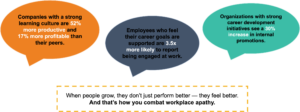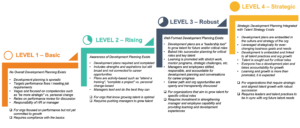In our recent webinar, we discussed using career development and development planning as strategy for building a learning culture that re-engages employees. Watch a replay here: Job Hugging to Job Hero-ing
Today’s workforce is in a paradox: Employees are staying, but they’re not growing. This “job hugging” trend means retention is high, yet engagement is low. Employees cling to their roles out of caution, but without clarity or purpose, workplace apathy sets in. For HR and People leaders, the challenge is clear: Retention alone isn’t the victory. True success for the organization happens when employees are not just staying, but growing.
What is Job Hugging?
Two Types of Job Huggers
Fear-Based Huggers: Holding onto their roles (for dear life!) out of fear of financial instability, the competitive job market, or the unknown.
High-Performing Huggers: Top talent who could make a change but hesitate because they’re comfortable in their role, skilled at what they do, and it feels risky or too hard to take on a new role or skill.
The Costs of Job Hugging
While job hugging can provide short-term stability for the organization with a continuity of knowledge and less disruption, it comes at the cost of long-term performance.
1. Illusion of Loyalty: The “quits rate” has sat at a steady 2% in recent months, its lowest sustained level since 2016. Low turnover can give the appearance of a loyal workforce, masking underlying disengagement.

2. Internal Bottlenecks: Engaged employees can get stalled waiting for opportunities that job huggers are holding onto. Job huggers who stay too long in key roles prevent other high performers from advancing, causing frustration and exit risk.

3. Stalled Innovation: Resistant to change, job huggers cling to comfort zones instead of taking risks or embracing new challenges, which stifles creativity and innovation within teams and the broader organization. Innovation is critical for a company’s market competitiveness.

What is a Job Hero?
A job hero is an individual who leverages their current role as a platform not just to deliver results, but to learn, grow, and make a meaningful impact beyond their immediate responsibilities. Job heroes take ownership of their own development, actively seek opportunities to improve and contribute, and embrace challenges.
Key Traits of a Job Hero
- Growth Mindset: Embraces challenges and views setbacks as opportunities to learn
- Proactive Learning: Seeks feedback, new skills, and stretch assignments
- Collaboration & Influence: Builds relationships and influences others beyond their formal authority
- Ownership & Accountability: Takes responsibility for both successes and failures, driving continuous improvement
- Purpose Driven: Connects their work to a broader purpose or mission
- Resilience & Adaptability: Navigates uncertainty with agility and a solution-focused attitude

How to Create a Culture that Cultivates Job Heroes
One of the most underutilized tools in organizations is personalized development planning. Employees want clarity on their growth path and regular conversations about their careers. People like having someone to talk to about where they’re going! Performance management may set the baseline, but career and coaching conversations push growth forward and keep people engaged. Personalized plans create ownership and help employees see their future within the company.
Career development isn’t just good for employees, it’s very good for business. Companies with strong learning cultures are significantly more productive and profitable. Employees who feel supported in their career goals are over three times more likely to report being engaged! When employees see progress and opportunity for themselves, they are more likely to put more discretionary effort into their roles and actively work on growing within the organization, rather than seek new roles and opportunities elsewhere.

3 Ways to Transform Job Huggers to Job Heroes
1. Restore Energy, Meaning, and Balance: Roughly nine in 10 Gen Zs (89%) and millennials (92%) consider a sense of purpose to be important to their job satisfaction and well-being. For years, organizations have emphasized the alignment of company values with personal values. Today, the conversation needs to go deeper because purpose has become the baseline for job satisfaction. For some, purpose is about professional development or gaining skills to grow their career. For others, it’s making enough money or having the flexibility to change their own world outside of work. More than anything, restoring a sense of purpose requires talking to employees about their individual needs and desires within the context of their career and work.
2. Promote Growth Through Challenge and Safety: Cultivate a psychologically safe environment where risks are encouraged. True development requires challenge, but also safety. Psychological safety allows people to step outside their comfort zones, take risks, and learn from mistakes. Assigning stretch projects that focus on learning (rather than just productivity) signals a genuine investment in growth. Normalizing mistakes as part of the process encourages innovation and resilience.
3. Drive Future Potential with Ambition & Rewards: Encourage and equip people managers to discuss growth opportunities and career pathways within the company. Development shouldn’t be a one-time event, but an ongoing conversation. Leaders can use development planning strategically, tying organizational goals to individual needs. Aligning rewards and recognition with growth behaviors reinforces the message even further.
The Role of Meaningful Career Development: How to Move Beyond Check-the-Box Development Plans
Career development consistently ranks among the top priorities for employees and executives alike. Yet despite its importance, most organizations under-deliver. While 83% of companies say learning and career growth are critical to their future, only 20–30% of employees report having a meaningful development plan with their manager. The gap between intent and execution is costing organizations engagement, innovation, and future-ready leadership.
For HR and People leaders, this is a call to action. Development planning isn’t just an HR exercise, it’s a leadership capability, a cultural differentiator, and a driver of business performance.
Why Common Approaches Fall Short
Many companies invest in programs that don’t deliver the lift they’re hoping for. Some of the most common challenges include:
- Learning libraries with low engagement: Online courses and content hubs are useful, but with engagement rate commonly being low, they rarely translate into growth without integration into development planning.
- “DIY development”: Placing full responsibility on employees to figure out their career path without adequate manager or organizational support leaves growth disconnected from business needs.
- Performance management without future focus: Reviews centered on accountability and goals miss the opportunity to inspire growth and readiness for future roles.
- Development as “fixing”: Using plans to address deficiencies creates stigma rather than motivation.
- Disguised workload as growth: Employees see through additional responsibilities masquerading as career opportunities.
- Narrow definitions of career growth: In flatter organizations, upward moves aren’t the only option. Without variety, employees disengage.
Why it fails: These approaches feel like extra tasks, disconnected from personal goals, team priorities, or real impact. Development should inspire, not exhaust or overwhelm people.
Better Alternatives that Drive Energy and Engagement
The organizations seeing success with development planning are investing in approaches that energize employees. What actually works:
- Personalized development planning: Plans that link performance, career aspirations, and personal change (not just competencies) create motivation and direction.
- Challenging, strategic work: Stretch assignments and action learning programs give employees real-world opportunities to build skills while contributing to business goals.
- Coaching and mentorship: One-on-one and group coaching broadens the sources of guidance, reducing over-reliance on managers.
- Personal growth conversations: Regular, future-focused career discussions with managers build trust and help employees see creative career path options.
Why it works: These approaches energize an individual in their personal career journey, which encourages learning, growth, and opportunity. Development should support both the individual and the organization.
The Business Case HR Leaders Can’t Ignore
Without robust career development, organizations face:
- Higher turnover of job heroes (aka your top talent): High-performing employees are the first to leave when internal opportunities aren’t clear.
- Weakened talent and leadership pipelines: Critical roles aren’t filled with qualified people.
- Lower engagement: Employees without development plans are less than half as engaged as those who have them.
- More job hugging: Employees without a plan for their growth are 2-3x more likely to disengage.
- Missed innovation and revenue: Companies with strong development cultures are 92% more likely to innovate and 30% more likely to be market leaders.
Development planning is an underdeveloped skill, and it has real costs in money, talent, and future business results. It is far more cost-effective to invest in development planning than to lose talent and leave innovation untapped.
A Four-Level Maturity Model for Development Planning
HR leaders can assess their organization against a stair-step maturity framework:

The Shift Executive HR Leaders Must Champion
Development planning is often misunderstood as a “fix-it” tool or an administrative burden. In reality, it’s about enabling personal change that builds both individual careers and organizational capacity. The shift requires moving from “doing more” to showing up differently – helping employees learn new ways of contributing within the flow of work.
CHROs and Talent leaders play a pivotal role in making this shift. By elevating development planning as a core business capability, leaders can unlock engagement, strengthen pipelines, and future-proof their organizations.
Wrapping it all up
For HR leaders, the opportunity lies in reimagining development planning as an organizational leadership discipline rather than an HR exercise. That means equipping managers with the tools to facilitate real growth conversations, creating visibility into career paths, and aligning development with organizational strategy.
How GrowWise Can Help
Our proprietary e-learning program GrowWise provides an advantage by embedding structure and support into a process that too often feels vague or inconsistent. GrowWise makes development planning practical, personalized, and scalable in a fun, easy-to-use, gamified way – helping managers hold meaningful career conversations, aligning personal growth with business strategy, and giving employees clear visibility into their future. When development planning becomes part of the culture, organizations see stronger pipelines, higher engagement, and greater agility for the future.
Reach out for a free 30-day trial!
